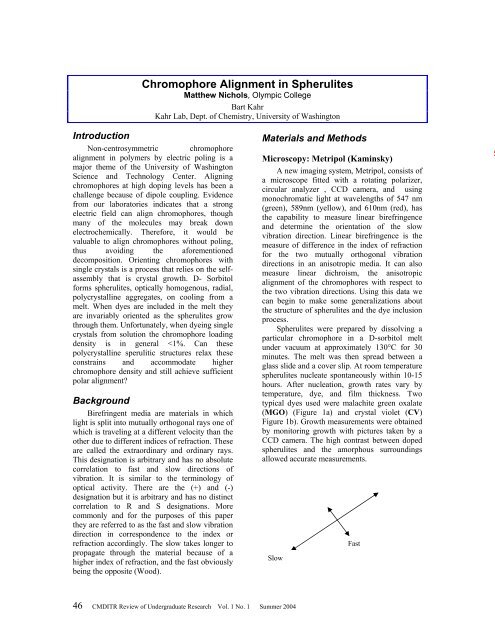CMDITR Review of Undergraduate Research - Pluto - University of ...
CMDITR Review of Undergraduate Research - Pluto - University of ...
CMDITR Review of Undergraduate Research - Pluto - University of ...
You also want an ePaper? Increase the reach of your titles
YUMPU automatically turns print PDFs into web optimized ePapers that Google loves.
Chromophore Alignment in Spherulites<br />
Matthew Nichols, Olympic College<br />
Bart Kahr<br />
Kahr Lab, Dept. <strong>of</strong> Chemistry, <strong>University</strong> <strong>of</strong> Washington<br />
Introduction<br />
Non-centrosymmetric chromophore<br />
alignment in polymers by electric poling is a<br />
major theme <strong>of</strong> the <strong>University</strong> <strong>of</strong> Washington<br />
Science and Technology Center. Aligning<br />
chromophores at high doping levels has been a<br />
challenge because <strong>of</strong> dipole coupling. Evidence<br />
from our laboratories indicates that a strong<br />
electric field can align chromophores, though<br />
many <strong>of</strong> the molecules may break down<br />
electrochemically. Therefore, it would be<br />
valuable to align chromophores without poling,<br />
thus avoiding the aforementioned<br />
decomposition. Orienting chromophores with<br />
single crystals is a process that relies on the selfassembly<br />
that is crystal growth. D- Sorbitol<br />
forms spherulites, optically homogenous, radial,<br />
polycrystalline aggregates, on cooling from a<br />
melt. When dyes are included in the melt they<br />
are invariably oriented as the spherulites grow<br />
through them. Unfortunately, when dyeing single<br />
crystals from solution the chromophore loading<br />
density is in general




